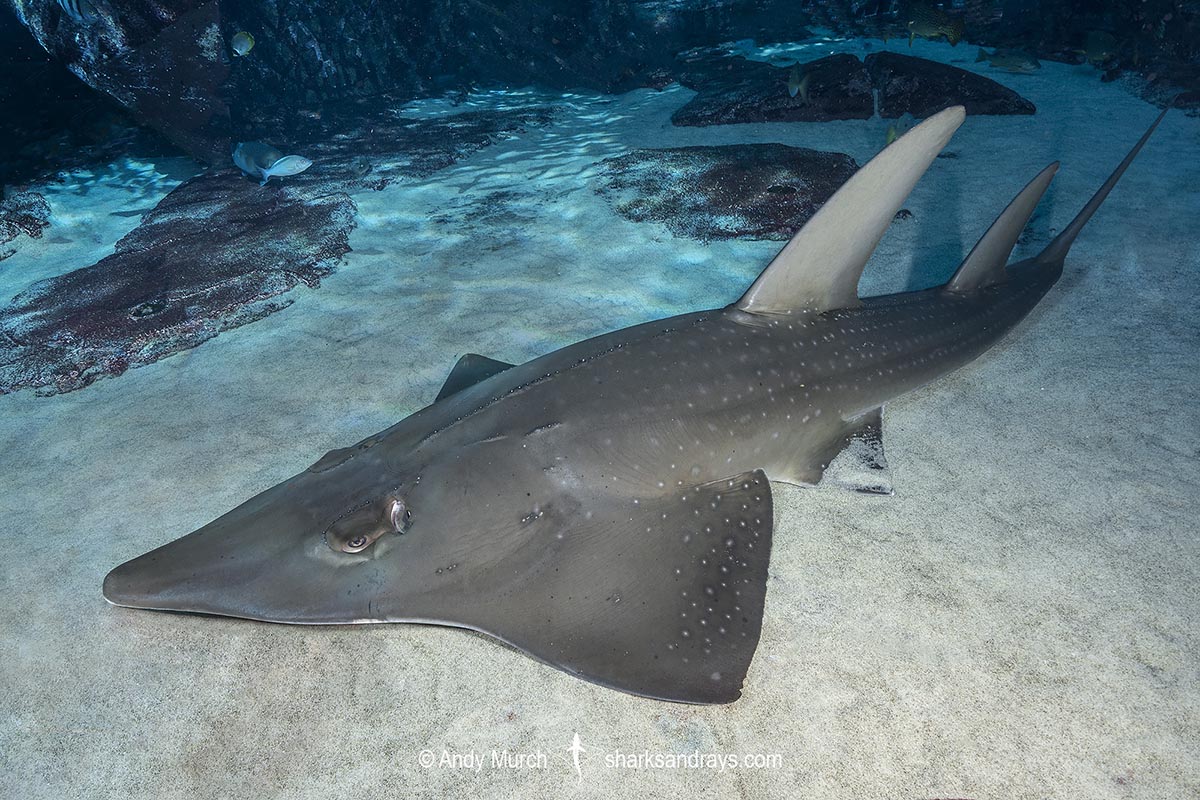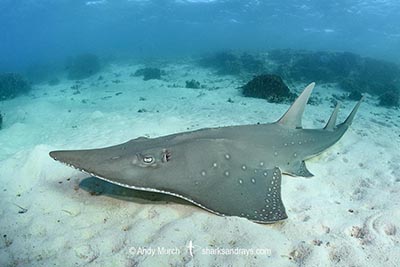Common names
Whitespotted Wedgefish, Giant Guitarfish.
Binomial
Rhynchobatus djiddensis.
Synonyms
Raja djiddensis, Rhinchobatus djiddensis, Rhinobatus djiddensis, Rhinobatus maculata, Rhynchobatis djiddensis, Rhynchobatus djeddensis, Rhynchobatus djiddenis, Rhynchobatus djidensis, Rhyncobatis djeddensis, Rhyncobatus djeddensis, Rhyncobatus djiddensis, Rynchobatus djiddensis.
Identification
A large wedgefish with an acutely pointed, somewhat ‘bottle-shaped’ snout. Snout length 3.6-4.7 x orbit length. Spiracles with 2 short, equally-sized skin-folds. Anterior margins of disc almost straight or weakly undulate. Pectoral apices bluntly angular, posterior margins straight. Prominent thorns present in a continuous row along midline, and around eyes and above spiracles. Two thorn rows on each shoulder; upper row broken into two sections, lower row very short. Sometimes with a small thorn patch on cheek.
Dorsal fins tall and falcate in adults. First dorsal fin slightly larger than second, origin anterior to pelvic fin insertion. Caudal fin large with a deeply concave posterior margin and well-defined lower lobe. Lateral keel present along posterior flank to caudal base.
Colour
Dorsum dark grey to yellowish-brown, with many small white spots or rings along flanks from ocelli level to tail. Spots form 4-5 rows along flanks; more noticeable in juveniles. Prominent, spiracle-sized of larger, dark ocelli often present on flank above pectoral fin. Dusky/dark mask often present across eyes. All markings may be indistinct or absent. Ventrum white, often with small dark spots near tip of snout.
Size
Maximum length 310cm. Size at birth ~60cm.

Conservation Status
CRITICALLY ENDANGERED
Shark-like rays (including sawfishes, wedgefishes, and giant guitarfishes) are considered the best quality fins for human consumption. In the international shark fin trade, their fins have the highest value, which has led to dramatic declines in many species, especially within the Rhinidae family. Their meat is also of high quality and is generally consumed locally.
Previously thought to be a much wider ranging species, the Whitespotted Wedgefish is now considered a western Indian Ocean endemic. Very little catch information is available from the west coast of Africa, but catch data from Iran indicates a 91% decline within the last three generations. South Africa is the only area where Rhynchobatus djiddensis may have some refuge from intense fishing.
Habitat
Tropical/subtropical seas. Demersal on soft substrates sometimes adjacent to coral reefs. From close inshore to 70m.
Distribution
Indian Ocean. Occurs from South Africa to Oman and the Arabian Gulf. The presence of giant guitarfish further east has not been determined due to confusion identifying closely related species of wedgefishes.
Reproduction
Aplacental lecithotrophic viviparous. Litter size ~4.
Diet
Feeds mainly on demersal fishes, crabs, and bivalves.
Behavior
Migratory. Tagged whitespotted wedgefishes from in KwaZulu-Natal, South Africa were largely absent in the winter, presumably moving north.
Reaction to divers
Difficult to approach.
Diving logistics
Due to overfishing, the whitespotted wedgefish is rarely encountered along much of the east coast of Africa but it still quite common in South Africa. Sightings occur at dive sites in Sodwana Bay, and beach fishermen frequently catch this species in Zululand and Kwa Zulu Natal, so dive sites all along that coastline could be productive during the summer months.
What’s new
View our full list of updates
Similar species
Bottlenose Wedgefish Distinguishable by more bottlenosed snout, lack of dusky mask across eyes, and less spots.
Smoothnose Wedgefish Distinguishable by straight anterior margins of disc.

